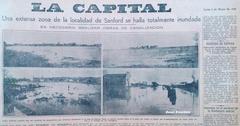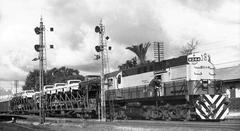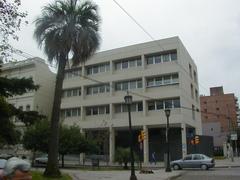Juan María Gutiérrez High School: Visiting Hours, Tickets, and Historical Information in Rosario, Argentina
Date: 03/07/2025
Introduction
Juan María Gutiérrez High School (Escuela Normal Superior Nº 2 “Juan María Gutiérrez”) is a cornerstone of Rosario’s educational and architectural landscape. Named after the influential Argentine intellectual, the school is not only a center of academic excellence but also an emblem of the city’s commitment to public education, cultural identity, and civic engagement. Its monumental early 20th-century architecture and ongoing role in community life make it a must-visit for history enthusiasts, architecture lovers, and travelers seeking to understand Rosario’s dynamic cultural heritage.
This guide offers a comprehensive overview of the school’s history, architectural features, and practical visitor information—including hours, admission, tours, accessibility, and nearby attractions—ensuring you get the most out of your visit.
Table of Contents
- Historical Background
- Architectural and Educational Significance
- Cultural Impact and Community Engagement
- Visiting Information
- Practical Tips for Visitors
- FAQs
- Conclusion
- References and Further Reading
Historical Background
Juan María Gutiérrez: The Namesake
Juan María Gutiérrez (1809–1878) was a renowned Argentine poet, jurist, scientist, educator, and reformer. As rector of the University of Buenos Aires from 1861 to 1874, he spearheaded educational modernization and the introduction of the natural sciences curriculum in Argentina (UC Santa Barbara Library). Gutiérrez’s dedication to critical inquiry, liberal values, and national culture made him an ideal figure for an institution committed to intellectual growth and civic responsibility.
Rosario’s Educational Evolution
Rosario, Argentina’s third-largest city, experienced rapid growth during the late 19th and early 20th centuries, driven by European immigration and industrialization (Wikipedia: History of Rosario). The city’s population became diverse and cosmopolitan, fostering an environment where public education was prioritized as a path to social mobility, scientific advancement, and civic participation. The establishment of schools like Juan María Gutiérrez High School was integral to Rosario’s transformation into a major cultural and intellectual hub (Rosario Turismo).
Architectural and Educational Significance
Construction and Design
Founded in 1910 as part of Argentina’s Centenary initiative to expand public education, Juan María Gutiérrez High School’s main building was designed by Augusto Plou. Construction began in 1928, and the building was inaugurated in March 1931 (ENS35 SFE). The architecture exemplifies early 20th-century monumentalism, with giant-order columns, grand arcades, ornate capitals, and a distinctive entrance arch. The design reflects both neoclassical and Italianate influences, symbolizing the era’s aspirations for educational grandeur (argentina.gob.ar).
The building is recognized as a “palacio-escuela” (palace-school), a term that underscores its architectural ambition and its intended role as a beacon of civic pride and learning. Careful preservation has maintained its original features, including a renovated assembly hall that continues to host cultural and academic events (MexicoHistorico.com).
Institutional Role
Originally a normal school, Juan María Gutiérrez High School was pivotal in training teachers who contributed significantly to educational development across the Santa Fe province (Wikipedia: Rosario - Education). Today, it remains a leading secondary institution, offering a curriculum that balances sciences, humanities, and civic education, in keeping with its namesake’s values.
Cultural Impact and Community Engagement
More than an academic institution, the school is deeply embedded in Rosario’s civic and cultural life. Its assembly hall and public spaces host events ranging from theatrical performances to literary debates, reinforcing its role as a community anchor (ENS35 SFE). The school’s inclusive spirit reflects Argentina’s commitment to universal education and social integration, especially in a city where nearly half the population was foreign-born by the 1920s (MundoAndino).
The school’s architectural and historical significance also contributes to Rosario’s heritage tourism, attracting visitors interested in the intersection of education, architecture, and urban identity (MexicoHistorico.com).
Visiting Information
Location and Access
- Address: Córdoba 2084, Rosario, Santa Fe, Argentina, C.P. 2000
- Central District: Walkable from major hotels, commercial areas, and cultural sites (myadventuresacrosstheworld.com)
- Transportation: Served by multiple city bus lines; taxis, ride-sharing, and nearby parking available (hikersbay.com)
Hours, Admission, and Tours
- School Hours: Monday to Friday, 7:30 AM–6:00 PM (subject to change during holidays and events)
- Public Access: Visits inside the building require advance arrangement, generally available during cultural events, open houses, or guided tours.
- Exterior Viewing: Free and available during daylight hours.
- Guided Tours: Can be arranged through the school’s administration; tours provide insights into the school’s history, architecture, and educational mission.
- Admission Fee: No general fee; some special events or guided tours may require registration.
Contact Details:
- Phone: +54 341 4721409/410/411/412
- Email: [email protected] (see official site for full contact list)
- School Contact Page
Visitor Guidelines and Accessibility
- Booking: Visits must be scheduled in advance, especially for group tours.
- Identification: Bring photo ID for entry.
- Photography: Allowed only with prior permission; respect students’ privacy.
- Dress Code: Modest attire recommended.
- Accessibility: Main entrances and exterior are accessible; historic interiors may pose challenges for visitors with limited mobility—contact the school for specific needs.
Nearby Attractions
- Calle Peatonal Córdoba and San Martín: Iconic pedestrian streets with historic architecture and lively street life (myadventuresacrosstheworld.com)
- Parque de la Independencia: Rosario’s largest park for leisure and outdoor activities.
- Museo de Arte Contemporáneo de Rosario (MACRO): Contemporary art museum in repurposed silos.
- National Flag Memorial: The city’s most renowned monument (cityplanet.org)
- Provincial Historical Museum “Julio Marc” and university campuses.
Practical Tips for Visitors
- Language: Spanish is predominant; some staff may speak basic English. Consider a translation app or guide (rosario.tur.ar).
- Currency: Argentine Peso (ARS); cash is useful for small purchases.
- Best Time to Visit: September–October for mild weather (myadventuresacrosstheworld.com).
- Safety: Central Rosario is safe during the day; standard precautions apply (hikersbay.com).
- Accommodation: Book in advance during festivals or school events.
FAQs
Q: What are the visiting hours for Juan María Gutiérrez High School?
A: Weekdays from 7:30 AM to 6:00 PM; interior access is by prior arrangement.
Q: Is there an admission fee?
A: No, exterior visits are free; guided tours or events may require registration.
Q: Are guided tours available?
A: Yes, by prior arrangement with the administration.
Q: Is the site wheelchair accessible?
A: Main entrances are accessible; some historic interiors may not be—contact the school for details.
Q: Can I take photographs inside?
A: Only with advance permission from school authorities.
Conclusion
Juan María Gutiérrez High School stands as a living testament to Rosario’s dedication to public education, cultural enrichment, and architectural preservation. Its striking design, storied history, and continued community engagement make it a highlight for visitors seeking to experience the essence of Rosario’s urban and educational development. By planning ahead and taking advantage of guided tours or special events, you can immerse yourself in a unique intersection of history, architecture, and local life.
For the latest updates on visiting hours, events, and cultural activities, visit the school’s official channels and consider using the Audiala app for real-time notifications and travel tips.






